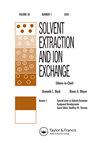Evidence of Supramolecular Origin of Selectivity in Solvent Extraction of Bifunctional Amidophosphonate Extractants with Different Configurations
IF 2.1
4区 化学
Q3 CHEMISTRY, MULTIDISCIPLINARY
引用次数: 6
Abstract
ABSTRACT Extraction mechanisms of two bifunctional extractants which differ only by the grafting of an alkyl chain between their two functions were investigated at molecular and supramolecular scales to investigate the origin of their very different separation factors toward uranium and zirconium. Investigation of the complex structure with spectroscopic analysis (Fourier Transform Infra-Red (FTIR), ElectroSpray Ionization Mass Spectroscopy (ESI-MS) and Extended X-Ray Absorption Fine Structure (EXAFS)) demonstrated that alkylation does not affect the chelation mechanism of uranium and zirconium. Stoichiometries of complexes remain identical for both extractants: UO2L2(NO3)2 and zirconium polynuclear complexes are formed after extraction into the organic phase. The origin of selectivity was therefore investigated by considering the supramolecular self-assembly of the two bifunctional molecules. Small-Angle X ray and Neutrons Scattering (SAXS and SANS) showed that the highest separation factors between U and Zr are obtained when smaller aggregates are formed. The results of this study therefore suggests that the selectivity is controlled by the supramolecular self-assembly of the two extractant molecules. Thanks to a smaller packing parameter, the non-alkylated molecule forms bigger aggregates analogous to reverse micelles that can extract additional polar species in their polar core through a solubilization effect, thus decreasing the separation factor between uranium and zirconium.不同构型双官能酰胺膦酸盐萃取剂溶剂萃取选择性的超分子起源证据
摘要在分子和超分子尺度上研究了两种双功能萃取剂的萃取机理,这两种萃取剂的不同之处仅在于其两种功能之间的烷基链的接枝,以研究它们对铀和锆的不同分离因子的来源。通过光谱分析(傅里叶变换红外光谱(FTIR)、电喷雾电离质谱(ESI-MS)和扩展X射线吸收精细结构(EXAFS))对复杂结构的研究表明,烷基化不影响铀和锆的螯合机制。对于两种萃取剂,配合物的化学计量保持相同:UO2L2(NO3)2和锆多核配合物在萃取到有机相中后形成。因此,通过考虑两个双功能分子的超分子自组装来研究选择性的起源。小角度X射线和中子散射(SAXS和SANS)表明,当形成较小的聚集体时,U和Zr之间的分离因子最高。因此,这项研究的结果表明,选择性是由两种萃取剂分子的超分子自组装控制的。由于较小的堆积参数,非烷基化分子形成了类似于反胶束的更大聚集体,反胶束可以通过增溶作用在其极性核心中提取额外的极性物质,从而降低铀和锆之间的分离因子。
本文章由计算机程序翻译,如有差异,请以英文原文为准。
求助全文
约1分钟内获得全文
求助全文
来源期刊
CiteScore
4.40
自引率
5.00%
发文量
15
审稿时长
8.4 months
期刊介绍:
Solvent Extraction and Ion Exchange is an international journal that publishes original research papers, reviews, and notes that address all aspects of solvent extraction, ion exchange, and closely related methods involving, for example, liquid membranes, extraction chromatography, supercritical fluids, ionic liquids, microfluidics, and adsorption. We welcome submissions that look at: The underlying principles in solvent extraction and ion exchange; Solvent extraction and ion exchange process development; New materials or reagents, their syntheses and properties; Computational methods of molecular design and simulation; Advances in equipment, fluid dynamics, and engineering; Interfacial phenomena, kinetics, and coalescence; Spectroscopic and diffraction analysis of structure and dynamics; Host-guest chemistry, ion receptors, and molecular recognition.

 求助内容:
求助内容: 应助结果提醒方式:
应助结果提醒方式:


